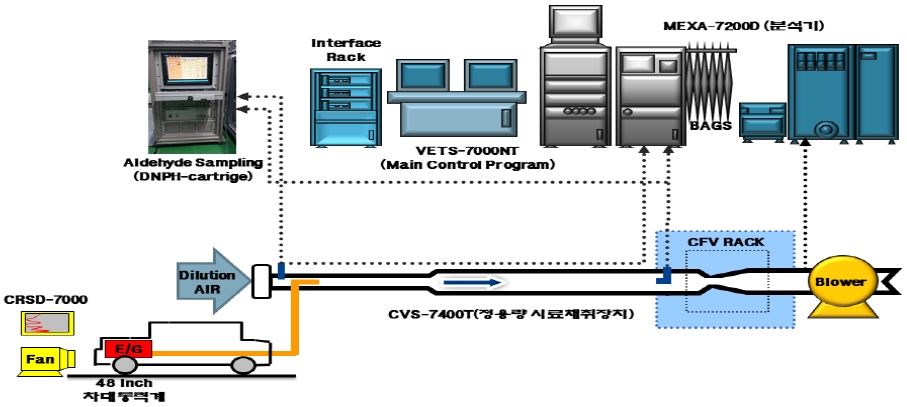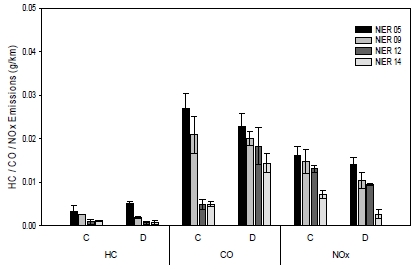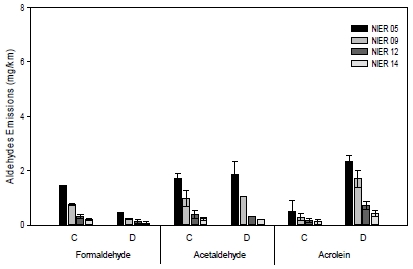
주행모드 및 연료유형에 따른 승용차의 알데히드류 배출특성에 관한 연구
 ; Sun-Moon Kim*
; Sun-Moon Kim* ; Sung-Woon Jung*
; Sung-Woon Jung* ; Yun-Sung Lim*
; Yun-Sung Lim* ; Jong-Tae Lee*
; Jong-Tae Lee* ; Hyung-Jun Kim*, †
; Hyung-Jun Kim*, †
Abstract
Emission characteristics on regulated pollutants and aldehydes of domestic passenger cars according to the driving modes and fuel types were conducted in this study. In order to compare emission characteristics, test cars with similar manufacturing year and mileage were selected. Also, the driving modes and various fuels were applied to the four driving modes (NIER 5, 9, 12, 14) and three fuel types (diesel, gasoline, LPG), respectively. Regulated pollutant emissions from passenger cars were measured by using chassis dynamometer and emission analyzer. In addition, aldehydes were collected in 2,4-DNPH cartridges using a sampling device in the CVS tunnel and analyzed using ultra high performance liquid chromatography. As a result, it was found that the regulated pollutants of the test vehicles decreased with an increase of the average vehicle speed, while the NOx emission increased at high vehicle speeds. Aldehydes emitted from diesel vehicles were higher than those of gasoline vehicles. In addition, formaldehyde and acetaldehyde accounted for more than 78% of the total aldehydes. In the case of LPG vehicles, acrolein was the highest at around 51-62%. Regulated pollutants and aldehydes emitted from cars are affected by fuel types and displacement and operating conditions. This study is expected to be used as basic data for the estimation of HAPs emissions inventory for mobile source.
Keywords:
Aldehydes, Passenger cars, Driving modes, Fuel types1. 서 론
자동차에서 배출되는 오염물질은 주로 대도시와 도로이동오염원에 따른 영향이 큰 지역에서 주된 대기오염의 주요 원인으로 확인되고 있어 자동차 배출가스에 대한 관심이 지속적으로 높아지고 있다. 따라서 일반적인 규제오염물질 이외에도 최근에는 미량으로 배출되는 유해대기오염물질(Aldehydes, VOCs, PAHs 등)에 대한 관심이 높아지고 있으며, 인체의 건강과 교통우심지역 등에 피해와 연관이 있을 것으로 보고되고 있다.1) 특히 이러한 유해대기오염물질은 저농도에서도 인체위해도가 높아 장기적으로 노출되면 인체의 각종 암과 질병을 유발시키기 때문에 지속적인 모니터링이 필요하다.2,3)
알데히드류는 광화학스모그와 오존 형성을 하는 등 대기 환경을 악화시킬 뿐만 아니라 인체의 정서적 불안정, 기억력 상실 등 정신적인 건강에 심각한 영향을 미치는 것으로 알려져 있다.4) 특히 포름알데히드는 광화학 산화반응에 의해 오존을 형성하며 인체의 암을 유발하는 물질로 국제암연구센터(IARC)에서는 발암물질 "Group 1"로 분류하여 관리하고 있다.5) 이와 같이 국외에서는 자동차의 유해대기오염물질 배출특성 결과를 바탕으로 독성, 발암성 등 인체 위해성을 평가하는 다양한 연구가 진행되고 있다.6,7)
이러한 추세에 발맞추어 유럽 EEA에서는 유종별로 구분하여 자동차 배출가스 NMVOC(Non-Methane Volatile Organic Compounds) 중 유해대기오염물질의 Speciation을 산출하였으며, 그 결과 알데히드류는 포름알데히드, 아세트알데히드, 아크로레인 등이 주로 검출되는 것으로 나타났다.6) 자동차 배출가스 허용기준 Euro 4, 5에 해당하는 휘발유와 경유 승용차에서 배출되는 포름알데히드와 아세트알데히드는 카르보닐류의 약 75% 이상을 차지하는 것으로 나타났으며, 휘발유에 비해 경유 승용차에서 높게 배출되는 것으로 보고하였다.8) 또한 경유 승용차의 카르보닐류는 포름알데히드, 아세트알데히드, 아크로레인 등이 주성분이며, 포름알데히드와 아세트알데히드는 오존을 형성할 수 있는 잠재력이 높은 것으로 연구결과에서 나타났다.6) 휘발유 및 경유 이외에도 LPG 자동차에 대한 미량유해물질 연구에서 포름알데히드, 벤젠, 1,3-부타디엔 물질들은 휘발유 자동차의 포름알데히드 배출 수준보다 낮다고 Pundkar 등9)이 보고하였다. 아울러, 국내에서도 자동차 유해대기오염물질에 대한 중요성을 인식하고, 차대동력계와 실도로 주행을 통해 유해대기오염물질에 관한 연구가 진행되고 있다.10) 하지만 국내 실정을 반영한 다양한 주행조건(저속, 중속, 고속) 및 연료유형(경유, 휘발유, LPG)에 따른 알데히드류를 연구한 자료는 아직도 많이 부족한 실정이다.
이에 본 연구에서는 국내에서 운행 중인 승용차를 대상으로 차대동력계와 배출가스 분석기를 이용하여 다양한 주행조건에서 배출되는 경유, 휘발유, LPG 승용차의 규제오염물질(HC, CO, NOx)과 알데히드류의 배출특성 및 구성성분비를 비교 분석하고자 하였다.
2. 실험방법
2.1 실험차량
본 연구는 다양한 주행모드와 유종에 따른 국내 운행 중인 승용차의 배출가스 특성을 비교하기 위해 제작연식과 주행거리가 유사한 경유 1대, 휘발유 2대, LPG 1대 총 4차종을 선정하였다. 특히 휘발유 승용차의 경우에는 연료분사방식이 다른 가솔린직분식엔진(GDI)과 포트분사식엔진(MPI)을 각각 1대씩 실험하였다. 저감장치로 디젤산화촉매장치(DOC)가 장착된 경유자동차와 삼원촉매가 적용된 휘발유와 LPG 자동차를 선정하였으며, 실험차량들의 상세 제원은 Table 1에 나타내었다.
2.2 주행모드
주행모드는 국립환경과학원에서 국내 운행조건을 반영하여 개발한 국내 도로 주행패턴인 NIER 모드를 사용하였다. 다양한 평균주행속도에 따른 배출특성을 분석하기 위하여 서울시 도심 평균통행속도(19.0 km/h)와 전국 고속도로 평균 제한최고속도(98.9 km/h)를 고려하여 NIER 5, NIER 9, NIER 12, NIER 14 모드로 선정하였다. Table 2에 각각의 주행모드 제원을 나타내었다.
2.3 배출가스 분석
배출가스 측정시스템은 Fig. 1과 같이 자동차를 구동할 수 있는 차대동력계(Zoellner, AVL, Austria), 다양한 주행모드를 구현하기 위한 보조운전장치(CRSD-7000, Horiba, Japan)와 규제오염물질을 분석할 수 있는 시료채취장치(CVS-7300T, Horiba, Japan), 희석터널, 배출가스 분석기(MEXA-7200H, Horiba, Japan) 등으로 구성하였다. Table 3과 Table 4에 차대동력계와 배출가스 분석기의 상세 제원을 나타내었다. 자동차 배출가스 분석은 실험 자동차의 부하 등을 구현할 수 있는 차대동력계 롤러 위에서 다양한 주행모드를 주행할 때, 배기관으로부터 배출되는 가스를 희석터널에서 희석공기와 함께 혼합된 후 정용량 시료채취장치(Constant Volume Sampler, CVS)로 유입된다. 이때 정용량 시료채취장치에서 혼합가스의 일부를 시료 채취백에 포집하여 배출가스 분석기로 각 성분의 농도를 분석하며, 실시간으로 터널온도, 유량 등을 측정하였다.
3. 결과 및 고찰
3.1 주행모드 및 연료유형에 따른 규제오염물질 배출특성
Fig. 2는 평균차속이 다른 주행모드별 2L 급 배기량의 경유와 휘발유 승용차에 대한 규제오염물질 배출특성을 나타내고 있다. 경유와 휘발유 승용차에서 배출되는 탄화수소(HC)와 일산화탄소(CO)의 배출량은 주행모드의 평균속도가 높아짐에 따라 감소하는 것으로 나타났는데, 이는 주행모드의 평균차속이 증가할수록 완전연소반응이 우세하기 때문에 불완전연소 시 발생하는 탄화수소 및 일산화탄소의 배출량이 감소한 것으로 판단된다. 또한 고속구간에서는 주행거리가 저속구간 보다 긴 영향도 있을 것으로 판단된다. 반면 휘발유 승용차의 질소산화물(NOx) 배출량은 평균차속이 높아짐에 따라 약간 증가하는 경향을 보이는데, 이는 연소온도와 연료량이 증가하였기 때문으로 판단된다. 경유 승용차의 경우 일정한 경향을 보이지 않았으며, 가감속 구간과 순간적인 부하가 많은 저속 주행모드에서는 실화를 방지하기 위해 EGR을 많이 사용할 수 없어 질소산화물이 높게 나타났고, 고속구간에서는 엔진의 높은 출력을 필요하기 때문에 흡입공기 대비 연료 분사량이 증가하여 NOx 배출량이 높은 것으로 판단된다.11)
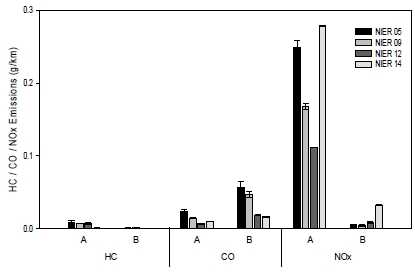
Emission characteristics of regulated pollutants from diesel and gasoline passenger cars according to NIER modes
경유 승용차의 질소산화물 배출량은 휘발유 승용차 대비 상당히 높게 나타났는데, 이는 경유 승용차는 별도의 질소산화물 저감장치 없이 배출가스재순환장치(EGR)만으로 저감하기 때문으로 판단된다.12)
Fig. 3은 평균차속이 다른 주행모드별 3L 급 배기량의 휘발유와 LPG 승용차에 대한 규제오염물질 배출특성을 나타내고 있다. 주행모드의 평균차속이 높아짐에 따라 휘발유와 LPG 승용차에서 배출되는 탄화수소, 일산화탄소, 질소산화물의 배출량은 감소하는 것으로 나타났다. 이는 가속과 감속이 많은 저속 주행모드에서는 연료 분사량의 증가로 공연비가 농후해지고 삼원촉매장치(TWC)의 촉매 활성화 온도 영향을 받은 것으로 판단된다. 휘발유 승용차의 질소산화물 배출량은 LPG 승용차보다 높게 나타났는데, 이는 LPG 연료의 에너지 밀도가 낮기 때문에 휘발유 연료에 비해 NOx 생성이 낮은 것으로 판단된다.12)
3.2 주행모드 및 연료유형에 따른 알데히드류 배출특성
Fig. 4와 Fig. 5는 배기량과 주행모드에 따른 각 실험 승용차의 알데히드류 배출특성을 나타내고 있으며, 모든 승용차의 포름알데히드와 아세트알데히드 배출량은 평균 차속이 증가할수록 감소하였다. 그러나 아크로레인 물질의 경우, 3,000 cc 휘발유와 LPG 승용차에서는 차속이 증가함에 따라 감소하는 경향을 보였으며, 이는 상대적으로 가속과 감속의 횟수가 많고 평균차속이 낮은 주행모드에서 승용차의 불완전연소, 촉매 변환장치의 낮은 산화효율 등의 영향으로 알데히드류의 배출량이 증가한 것으로 판단된다.13) Myung et al.(2014)의 연구결과에서도 휘발유와 LPG 승용차의 포름알데히드, 아세트알데히드, 아크로레인 배출량은 평균 차속이 증가함에 따라 후처리장치의 촉매 온도가 높아지기 때문에 감소한다고 보고된 바 있다.14)
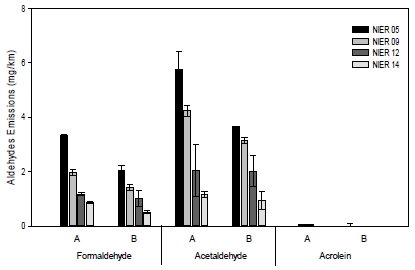
Emission characteristics of aldehydes from diesel and gasoline passenger cars according to NIER modes
2,000 cc 경유 승용차의 알데히드류 배출량은 휘발유 승용차보다 높은 것으로 분석되었다. 선행연구에서도 휘발유보다 경유 승용차에서 포름알데히드, 아세트알데히드, 아크로레인 등의 물질이 더 높게 배출되는 것으로 나타났으며, 알데히드류의 반응성은 휘발유 승용차의 삼원촉매장치(Three Way Catalytic Converter, TWC)에서 좋은 것으로 보고하였다.4,8)
3,000 cc LPG 승용차의 아세트알데히드와 아크로레인 배출량은 휘발유 승용차보다 높은 것으로 분석되었는데, LPG 승용차는 낮은 연소가스 온도에서 촉매 활성을 지연시키고 연소실 내에서 LPG 연료가 부분 산화하기 때문에 휘발유보다 더 많은 알데히드류를 생성한 것으로 판단된다.14)
3.3 주행모드 및 연료유형에 따른 알데히드류 구성성분비
Fig. 6과 Fig. 7에 주행모드의 평균속도에 따른 알데히드류 구성성분 변화를 확인하기 위하여 개별 물질의 구성비를 나타내었다. 2,000 cc 경유와 휘발유 승용차의 알데히드류 구성비는 아세트알데히드(56.9~68.1%, 64.1~68.9%), 포름알데히드(31.9~43.1%, 31.1~35.9%) 순으로 나타났으며, 평균차속이 증가할수록 포름알데히드의 구성비가 미세하게 증가하는 것을 확인하였다. 휘발유 및 경유 승용차에서 30% 이상의 구성비를 가지는 포름알데히드는 IARC에서 인체 발암물질로 규정하고 있어 지속적인 모니터링을 통한 관리가 필요할 것으로 사료된다.
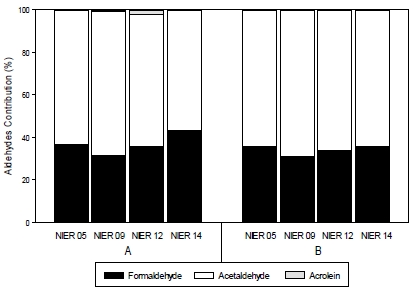
Groups for aldehydes composition of diesel and gasoline passenger cars with displacement of 2000 cc according to NIER modes
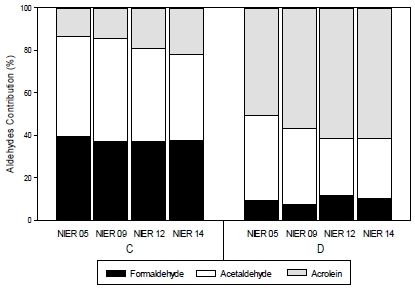
Groups for aldehydes composition of gasoline and LPG passenger cars with displacement of 3000 cc according to NIER modes
3,000 cc 휘발유와 LPG 승용차에서는 포름알데히드, 아세트알데히드 물질 이외에 아크로레인 물질이 추가로 검출되었다. 휘발유 승용차의 알데히드류 구성비는 아세트알데히드(40.8~48.5%), 포름알데히드(36.9~39.4%), 아크로레인(13.7~21.8%) 순으로 나타났으며, LPG 승용차는 아크로레인(50.6~61.5%), 아세트알데히드(26.8~40.3%), 포름알데히드(7.6~11.6%) 순으로 나타났다. 아크로레인은 평균차속이 증가함에 따라 구성성분비가 높아지는 것으로 나타났으며, 인체의 폐, 피부 등에 자극성이 높은 물질로 지속적인 관심이 필요한 물질이다.
또한 알데히드류는 탄화수소의 불완전연소로 형성되며, 운전조건뿐만 아니라 연료유형 및 배기량 등의 영향을 받는 것으로 판단된다.
5. 결 론
본 연구에서는 다양한 주행조건에서 배출되는 경유, 휘발유, LPG 승용차의 규제오염물질과 알데히드류의 배출특성 및 구성성분비를 비교 분석하였으며, 결론은 다음과 같다.
1) 규제오염물질은 배기량과 연료유형에 상관없이 전반적으로 주행모드의 평균속도가 증가함에 따라 감소하는 경향을 보였으나, NOx 배출량은 고속주행 시 높은 것으로 나타났다.
2) 주행모드에 따른 연료 유형별 알데히드류의 분석결과, 평균 차속이 증가할수록 포름알데히드, 아세트알데히드, 아크로레인의 배출량은 감소하였다.
3) 2,000 cc 경유 승용차의 알데히드류 배출량은 휘발유 승용차보다 높았으며, 3,000 cc 휘발유 승용차의 포름알데히드는 LPG 승용차보다 높았으나, 아세트알데히드와 아크로레인은 LPG 승용차에서 높게 배출되었다. 알데히드류는 탄화수소의 불완전 연소에 생성되며, 운전조건, 차량 배기량, 연료유형 등의 영향을 받는 것으로 판단된다.
4) 휘발유와 경유 승용차의 알데히드류 중 아세트알데히드는 약 40~68.9%, LPG 승용차는 아크로레인이 약 51~62%로 가장 높게 배출되어 연료유형에 따라 다른 경향을 보였다.
5) 본 연구의 결과는 향후 국내 자동차 유해대기오염물질 배출량 산정 및 저감을 위한 기초자료로 활용될 수 있을 것으로 판단된다.
Acknowledgments
본 연구는 환경부의 재원으로 국립환경과학원의 연구비 지원으로 수행되었습니다(과제번호: NIER-RP2015-352).
References
- South Coast Air Quality Management District, 2015, "Multiple Air Toxics Exposure Study in the South Coast Air Basin(MATESⅣ)", 1-800-CUT-SMOG.
- EPA, 2006, "The Master List of Compounds Emitted by Mobile Sources", EPA 420-B-06-002.
- EPA, 2007, "Control of Hazardous Air Pollutants from Mobile Sources", EPA 420-R-07-002.
-
J. H. Tsai, S. Y. Chang and H. L. Chiang, 2012, "Volatile Organic Compounds from the Exhaust of Light-Duty Diesel Vehicles", Atmospheric Environment, 61, pp. 499-506.
[https://doi.org/10.1016/j.atmosenv.2012.07.078]

- IARC, 2018, "Agents Classified by the IARC Monographs", Volumes 1-121.
- EEA, 2016, "EMEP/EEA Air Pollutant Emission Inventory Guidebook 2016", ISSN 1977-8449.
- EPA, 2015, "Speciation of Total Organic Gas and Particulate Matter Emissions from On-road Vehicles in MOVES 2014", EPA-420-R-15-022.
-
L. Cedric, L. Yao, T. Patrick, P. Pascal, C. Agnes and A. Michel, 2016, "PAH, BTEX, Carbonyl Compound, Black-Carbon, NO2 and Ultrafine Particle Dynamometer Bench Emissions for Euro 4 and Euro 5 Diesel and Gasoline Passenger Cars", Atmospheric Environment, 141, pp. 80-95.
[https://doi.org/10.1016/j.atmosenv.2016.06.055]

- A. H. Pundkar, S. M. Lawankar and S. Deshmukh, 2012, "Performance and Emissions of LPG Fueled Internal Combustion Engine: A Review", International Journal of Scientific & Engineering Research, Vol. 3, Issue 3, ISSN 2229-5518.
-
S. W. Han, T. H. Chung, J. H. Kim, S. J. Seo, J. M. Jeon, J. S. Chae, S. C. Hwang, M. S. Chon, J. P. Cha and J. S. Han, 2018, "Emission Characteristics of Hazardous Air Pollutants in Gas-phase Emitted from Commercial Vehicles Using PEMS on Real-road Driving", Journal of the Korean Society of Urban Environment, Vol. 18, No. 3, pp. 327-337.
[https://doi.org/10.33768/ksue.2018.18.3.327]

-
T. H. Chung, S. M. Kim, S. H. Mun, H. K. Hong, S. H. Lee, S. J. Seo, J. H. Kim, S. W. Jung, I. G. Kim, J. C. Lee and J. T. Lee, 2010, "A Study on NO2/NOx Ratio and NOx Emission Characteristics of Heavy-Duty Diesel Vehicles", Journal of Korean Society of Environmental Engineers, Vol. 41, No. 4, pp. 221-227.
[https://doi.org/10.4491/KSEE.2019.41.4.221]

- H. J. Kim, J. T. Lee, Y. H. Seo and Y. D. Hong, 2017, "Investigation on the Comparison of Exhaust Emission Characteristics of Passenger Cars using LPG and Diesel Fuel in Variation of Driving Mode and Ambient Conditions", Journal of ILASS-Korea, Vol. 22, No. 4, pp. 185-189.
-
D. Dong, M. Shao, Y. Li, S. Lu, Y. Wang, Z. Ji and D. Tang, 2014, "Carbonyl Emissions from Heavy-Duty Diesel Vehicle Exhaust in China and the Contribution to Ozone Formation Potential", Journal of Environmental Sciences, 26, pp. 122-128.
[https://doi.org/10.1016/S1001-0742(13)60387-3]

-
C. L. Myung, A. Y. Ko, Y. S. Lim, S. M. Kim, J. T. Lee, K. H. Cho and S. S. Park, 2014, "Mobile Source Air Toxic Emissions from Direct Injection Spark Ignition Gasoline and LPG Passenger Car under Various in-use Vehicle Driving Modes in Korea", Fuel Processing Technology, 119, pp. 19-31.
[https://doi.org/10.1016/j.fuproc.2013.10.013]

T. H. Chung; Conceptualization, Supervision, Investigation. S. M. Kim; Conceptualization. S. W. Jung; Conceptualization. Y. S. Lim; Project administration. J. T. Lee; Project administration. H. J. Kim; Supervision, Conceptualization, Writing–review & editing.

